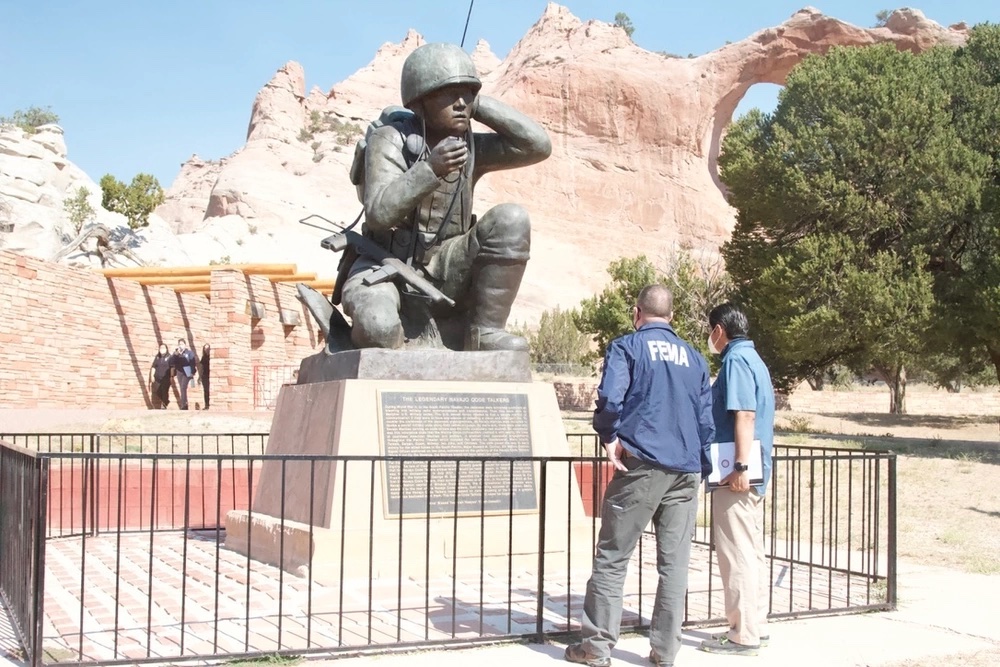
The Federal Emergency Management Agency released its first-ever tribal strategy with a focus on fostering stronger communication and collaboration on resilience, preparedness and disaster response along with ingraining greater cultural understanding in the FEMA workforce.
FEMA said it developed the 2022-2026 FEMA National Tribal Strategy to “address its responsibilities to federally recognized Tribal Nations and to identify unified agency actions to build, enhance, and sustain its relationships with tribes.”
In an introduction to the strategy, FEMA Administrator Deanne Criswell said that 135 representatives from 78 Tribal Nations “contributed critical feedback” to the effort “to help us become the FEMA that Tribal Nations need and deserve.”
“As emergency managers, we must be proactive and deliberate in our support to Tribal Nations as they build climate-resilient and prepared communities,” Criswell wrote. “We will only be successful when our programs are fully accessible to tribal communities. We must strive toward delivery of assistance that meets their unique needs.”
FEMA said that the strategy, which aligns with FEMA’s 2022-2026 Strategic Plan, was shaped through extensive outreach sessions led by FEMA National Tribal Affairs Advisor Denise “Bambi” Kraus. There are currently FEMA Regional Tribal Liaisons and/or FEMA Integration Team members located in the 10 FEMA regional offices.
The first goal of the National Tribal Strategy, instilling equity as a foundation in emergency management, will “evaluate and identify methodologies and strategies to increase regular engagement with Tribal Nations at FEMA regional and headquarters levels in a manner that acknowledges tribal sovereignty and ensures accessibility to FEMA resources.”
This includes developing tribal-specific technical assistance resources; convening an annual meeting of the National Tribal Affairs Advisor, Regional Tribal Liaisons, and tribal FEMA Integration Team staff and other subject matter experts “to discuss program work underway and develop recommendations on how FEMA (directed to regions and HQ) could better serve Tribal Nations” and crafting an annual report; connecting Tribal Nations leaders to the FEMA administrator through an annual update and ensuring FEMA leaders visit tribal communities; and supporting equitable opportunities for tribes to access FEMA programs and resources by prioritizing “inclusion of FEMA Regional Tribal Liaisons in internal and external national meetings and briefings,” conducting “an internal review of programs and policies that may inhibit equitable Tribal Nation access to FEMA programs and resources and commit to affecting legislative, regulatory, and policy changes that will enhance tribal access,” hiring more FEMA Integration Team staff, and translating FEMA materials into Native American languages.
The second goal focused on community climate resilience will “develop a report of current tribal needs and capabilities in the field of emergency management so that FEMA can better tailor training and technical assistance.”
“This task should include tribal consultation and include tribal histories of disasters, as appropriate,” the strategy says. “As part of the tribal outreach for this task, the FEMA Administrator and National Tribal Affairs Advisor will visit FEMA regions to meet with regional staff. These regional meetings will also extend to Tribal Nations in that region with an emphasis on interacting with those tribes FEMA has not worked with in the past.” A FEMA program will be created “to build on tribal mitigation planning for all hazards… including support to adapt to changing sea levels and other atmospheric impacts, as well as geologic hazards such as earthquakes, landslides, and tsunamis.”
A standardized training course will be developed for the FEMA workforce that will cover history and tribal sovereignty, and training opportunities will be offered to Tribal Nations including integration into the National Exercise Program and technical assistance on competitive FEMA grant programs and opportunities.
The third goal of promoting and sustaining a ready FEMA and a prepared nation includes increasing “FEMA cultural competency” to “ensure tribal equities are addressed by a trained and culturally sensitive workforce at all levels of the agency, to include headquarters, regions, and contractors, prior to on-site deployments.” FEMA staff will “collaborate with Tribal Nations before, during, and after disasters to provide financial assistance based on 1) their identified needs and 2) in accordance with laws and regulations governing FEMA mitigation, response, and recovery programs to improve disaster preparedness including coordination with interagency partners where and when applicable,” the strategy states.
To enhance federal incident support capability, the National Response Coordination Center (NRCC) Tribal Desk will collaborate with Regional Response Coordination Centers (RRCC), the FEMA Office of Response and Recovery, and relevant interagency partners to “ensure there are no unmet Tribal Nation needs or challenges,” and FEMA pledges to create “opportunities for tribal leaders to voice concerns to FEMA leadership that support its understanding of ongoing needs and concerns of affected Tribal Nations.”
A Tribal Affairs Work Group will be convened within FEMA, with representatives from FEMA programs at the headquarters and regional levels, and FEMA leadership will also meet with leaders of other federal departments and agencies that serve Tribal Nations “to share information on what resources are available, review legal authorities, and develop products to clarify available assistance.” Monthly FEMA Tribal Affairs meetings will be convened with tribal emergency managers to evaluate communication platforms for effectiveness, and tribal-specific national and regional engagements will be offered “to provide a forum to hear from tribes directly to empower tribal readiness and support tribal objectives.”
“FEMA, now, has a roadmap which refines and elaborates on major strategic goals and objectives – a roadmap representative of the voices we must better serve,” Criswell said. “From aggressive expansion of our tribal affairs footprint across our regional and headquarters offices, to developing tribal-specific technical assistance programs, we are committed to better supporting and honoring our federal trust responsibility and nation-to-nation relationship.”
"strategy" - Google News
August 26, 2022 at 07:43AM
https://ift.tt/DanfyEA
FEMA's First-Ever National Tribal Strategy Focuses on Building Better Collaboration and Understanding - HS Today - HSToday
"strategy" - Google News
https://ift.tt/vLFo97P
https://ift.tt/wO5ZmEu
Bagikan Berita Ini














0 Response to "FEMA's First-Ever National Tribal Strategy Focuses on Building Better Collaboration and Understanding - HS Today - HSToday"
Post a Comment